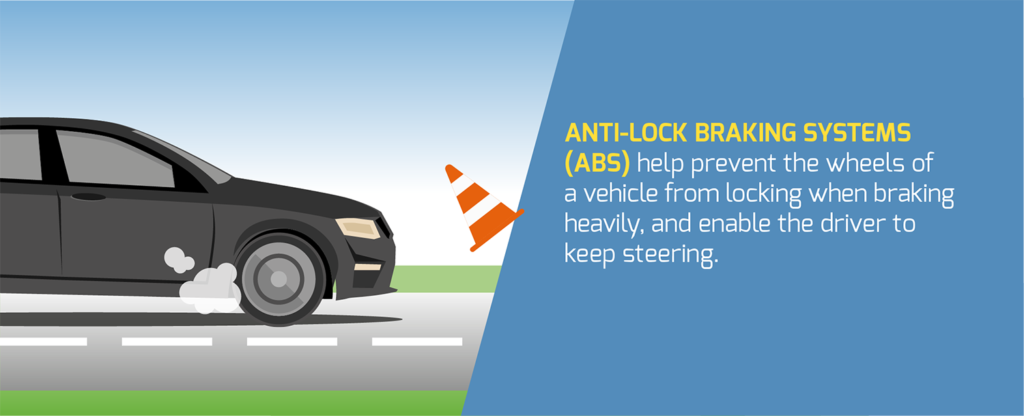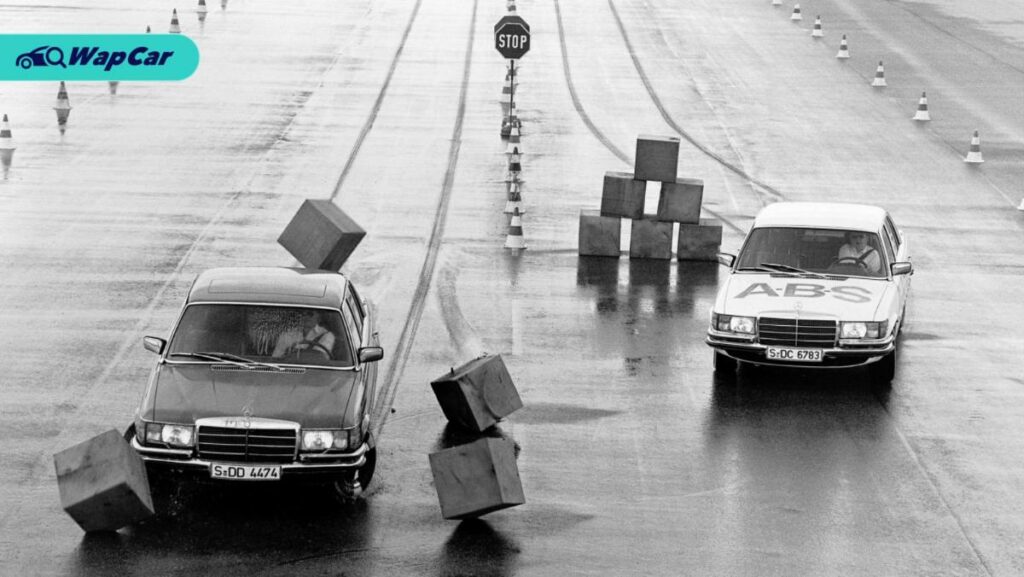Have you ever had to steer around a sudden obstacle and brake at the same time? Probably yes. It would seem that this is not difficult – apply a brake, turn a steering wheel and correct a trajectory. However, everything is relatively simple up to a certain point. If you press the brake pedal harder than necessary during emergency braking, wheels may lock and…
Then there are two possible scenarios. Both are due to the presence or absence of an anti-lock braking system (ABS). If a car is archaic, and has its genealogy from the mid-70s, then no matter how hard you turn the steering wheel, the vehicle won’t change the trajectory. The fact is that locked wheels, skidding, deprive the driver of the opportunity to maneuver – when the car fishtails, it will just drive in a straight line, as if the steering wheel was cut off. Only an experienced driver will be able to coolly unlock the wheels by releasing the brake pedal for a moment. And then, using impulse braking, return control and reduce speed. The second option is for a car equipped with ABS. The driver is only required to press the brake pedal harder and work with the steering wheel calmly. Do you feel the difference?
Locking is also dangerous because it can cause a car to skid or move to the side. This can happen when there is a diverse pavement under the wheels, the loading on the axles is greatly changed during the previous maneuver, or there are different tires. In addition, when the wheels are locked, the car can change its trajectory under the influence of any lateral force (road slant or collision). It is almost impossible to correct the trajectory in this case.

An increase in the braking distance is another negative effect of blocking. Here the whole point is that the static friction force is usually greater than the sliding friction force. Therefore, in order to stop the car as quickly as possible, it is necessary to generate such a value of pressure in brake lines that the wheels rotate on the verge of locking when braking. There is such an important indicator as relative slip. Depending on the degree of braking of the wheel, it can vary from zero (the wheel rolls without slipping) to 100% (the wheel is completely locked). It has been experimentally established that the maximum braking efficiency is achieved at 15-20% slippage – that is, in the case when the speed of rotation of the braked wheel is 15-20% lower that the speed of the free-rotating wheel at a constant speed of a car. Looking ahead, we can say that the electronics maintain this value during braking, periodically locking and unlocking the wheels.
Progressive humanity finally realized the harm of locked wheels only in the 70th of the last century. The pioneer in this field was Mercedes-Benz, which together with Bosch developed a system that in 1979 began to be installed on the Mercedes S-Class. The basic principle of ABS operation was formed exactly then, and then only improved.
The task of ABS is to regulate the speed of wheels’ rotation by changing the pressure in brake system lines. To control the rotational speed, you need to know its value and how it changes over time. Each wheel is equipped with a sensor that emits electrical impulses with a frequency proportional to the speed of the wheel’s rotation. This information is sent to the ABS control unit.
If the rotational speed of the wheel approached zero during braking, the electronic brain will immediately decide to release the brakes. A hydraulic modulator will bleed off the pressure from the line with the help of an electric valve and redirect the “extra” portion of brake fluid to the hydraulic accumulator. The pressure will decrease until the wheel, again “grabbing” the coating, spins up to a certain speed. Next, ABS will again sharply increase the pressure in the line and slow down the wheel. The cycle will continue until the car stops or the driver releases the pedal pressure to a position where ABS is not needed.
Many will say: “it doesn’t require much wisdom!” You can brake intermittently yourself. And it’s true: in many cases, this method of slowing down on cars not equipped with ABS allows you to avoid a sudden obstacle during emergency braking. When the wheels are locked – you brake, as soon as they are released – you get the opportunity to correct the direction. Naturally, in this scenario, the braking distance will increase significantly, but the driver will be able to bypass the obstacle and extinguish the skid with a preventive operation of the steering wheel.
But, unfortunately, no titled racer is able to provide “portion” braking with the frequency with which ABS does it. The system (depending on the version) manages to lock and unlock the wheels about 15 times in a second. In addition, the driver simultaneously applies all the braking mechanisms (this is how the first ABS systems worked), while modern 4-channel anti-lock braking systems monitor the speed of rotation and adjust the braking force for each wheel separately.
In most modern cars, ABS works together with EBD (Electronic Brake Distribution) – a brake force distribution system that measures the braking intensity for each wheel. With EBD, you can safely brake in a turn and on a “mixed track”. Electronics will understand by the difference in rotational speeds that the wheels have entered sections with a diverse pavement, and will reduce the braking forces on wheels that have better traction. By the way, the intensity of deceleration will decrease and will be determined by the friction force of the wheel(s) having the worst road grip.
It’s worth noting that for maximum deceleration efficiency, the brake pedal on cars with ABS must be pressed into the floor with all your strength. However, the latter isn’t necessary for those drivers whose cars are equipped with the Brake Assist system, which itself creates excessive pressure in the brake line, “slowing down” instead of a weak or indecisive person. It doesn’t interfere with regular slowdowns. However, Brake Assist regards a sharp pressing (slamming) on the pedal as a signal for emergency braking and takes effect.

But not everything is so smooth. ABS, like any other system, has disadvantages. For example, a simple ABS can lose to ordinary brakes on snow, ice and sand, negate the advantages of studded tyres. After all, on ice, studs provide the greatest deceleration only at the maximum relative slippage, when they dig into the ice like claws and furrow it. The trick is that ABS, trying to break the wheels, doesn’t allow the studs to work and thereby increases the braking distance. The same thing happens on dirt roads (sand, gravel, clay) and surfaces covered with snow.
Cars with ABS in this case have a longer braking distance, because constantly unlocking wheels don’t create a “plow effect”. But it is on such surfaces that the locked wheels have the maximum braking efficiency – due to the fact that rake “rollers” out of ground or snow in front of them. That’s why you need to remember: the braking distance of a car not equipped with ABS may be shorter on an icy, snow-covered or unpaved surface.
ABS can also do some dirt on an uneven road. If one wheel hangs in the air for a moment during braking and gets locked, the deceived electronics will start saving you from skidding and immediately reduce the pressure in the other lines. In a turn, the car will unpleasantly wag its “tail”, and the braking distance will increase. In principle, no one is insured against such accidental breakaway, but we must remember that the key to adequate ABS operation is a serviceable suspension.
Progress gives birth to more and more advanced systems. Operating with a large number of indications, they are able to adapt to the type of road surface and brake according to one of the preprogrammed algorithms. Of course, the electronics can’t be perceived as a panacea, but statistics are a stubborn thing: properly configured ABS with all serviceable car systems on dry and wet surfaces on average helps to save up to 20% of the braking distance and leaves the driver a chance to maneuver. Needless to say, life and health can depend on these precious meters.

This is a translation. You can read the original here: https://www.drive.ru/technic/4efb331400f11713001e38cb.html

Published December 16, 2021 • 7m to read



